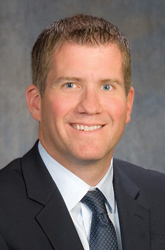Issues & Answers Special Advertising Section
November 2020

Joe Murphy
Chief Operating Officer
Coverys

“At Coverys, we’re committed to helping providers reduce the endless distractions that keep them from focusing on patient care which have become increasingly difficult to providers during this time of pandemic.”
Broadly speaking, our business has not been materially impacted by COVID-19. Certainly, we have insureds who have been adversely impacted, and we’ve responded by providing underwriting accommodation through endorsements and credits, and offering premium deferrals. To date, we’ve processed nearly a thousand credit endorsements. The overall premium impact is still within what we thought it would be back in the early days of the pandemic in March. We continue to renew business and write new business. Our retention rate is right in the margin that we’d like it to be in. While I can’t speak specifically to other writers, there clearly continues to be competition in pockets, with continued aggressive pricing. The overall market has been firming up, but there’s still ample capacity within the traditional admitted market.
What role is telemedicine playing today, and is that being driven by the pandemic?The movement toward virtual care has absolutely been driven by the pandemic. We’ve made more progress, in terms of the adoption of telemedicine in the last six months, than we’ve made in the last six years. It’s important to know that telemedicine is a highly organized and structured model that’s been around for a number of years. It was safely designed for a physician to use with recommended protocols, and now with the pandemic the barriers to use telemedicine have been modified or relaxed.
Have you noticed an increase in physician migration?
Within our traditional book of admitted business, we’ve not necessarily seen a difference in 2020 from, say, 2019, or even earlier years. However, the longer-term effects of COVID aren’t known as of yet. It’s anyone’s guess how that will pan out as we head into 2021. With that said, we continue to see strong retention, and we continue to see and win new business opportunities. With severity trends moving north of 3% in many jurisdictions, and the exponential growth of paid, large losses, it remains to be seen if it will have an impact on hospital systems.
How is technology changing MPL?
As an industry, historically, in the medical professional liability area, we’ve always looked at data that we have access to in evaluating risk. But this has really been a look at it in the past tense—true both in terms of premium pricing and in terms of managing risk based on what has already happened. Now, however, we’re watching the delivery of care shift to new models in front of our very eyes. It isn’t just the pandemic that is doing this. The movement toward value-based care was already catalyzing new approaches to traditional medicine. If we look at things like payment reform, those existed outside the Affordable Care Act. Those are things that were occurring because insureds were demanding that something be done about the increasing cost of health care. As these changes occur, we need ways to look forward to predict what will happen in the future, to predict risk, to understand these emerging vulnerabilities, and to help providers, practices, and hospitals proactively manage those risks.